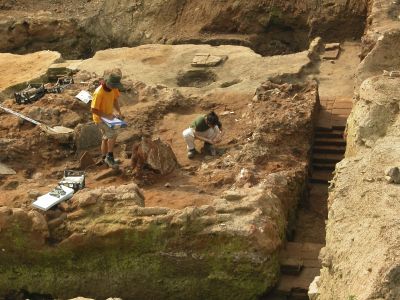













































Archaeologists from Freie Universität Berlin unlock the long-lost past of the Assiut region
A German-Egyptian excavation team has made a find in the mountain at Assiut, 375 kilometers south of Cairo – a smelly one. It is a tomb for dogs, stacked high with mummified carcasses. Since 2003, Professor Jochem Kahl of Freie Universität Berlin and his colleagues have been exploring the mountain at Assiut – the first foreign excavation team in more than 100 years to do so.
Over the course of their work, the researchers have filled almost 200 wooden crates, 80 by 60 by 40 centimeters in size, with dog mummies, most of them moldering. Outside, it’s 35°C (95°F) in the shade, while inside, workers contend with mold spores. Their work would have been impossible without special protective breathing masks.
“It’s really a test of endurance,” says dig leader Kahl. “We’ve been struggling away in there for three years, and we still haven’t reached the floor.” Animal worship was widespread in Egypt from the 7th century BC to the 2nd century AD, when people believed their gods took the form of dogs, jackals, and foxes – and entombed the dead animals as offerings to them.
The mountain at Assiut is full of these kinds of archaeological treasures; even Kahl was surprised to see just how full. The first campaign – the word used for a dig cycle – was funded with his own money. With four researchers in tow, he set off up the mountain for the first time over nine years ago – and found his great research task waiting for him there. People are constantly asking him how long he plans to keep working there, he says. Kahl’s response: “At least until I retire!”
About half a million people live at the foot of the mountain. To date, though, hardly anyone has been to the top, since the region has been a military zone since the 1960s, with access strictly prohibited. “Back in the 1980s, my professor at the time tried to get a permit, but the risk of terrorist attacks was too high,” Kahl recalls. The chance to dig at the site was quite a stroke of luck. Since as far back as the fifth campaign, in 2007, the project’s long-term planning has also been secure; the German Research Foundation (DFG) is financing the dig until 2017. Having that much time is a huge advantage, Kahl says.
Still, Kahl always worries about facing a sudden stop to his activities. The political situation in Egypt is prone to rapid change, as last year’s revolution showed. Assiut is also a seismically active area. Deep cracks in the stone serve as reminders that huge blocks could come crashing down at any time, burying treasures thousands of years old forever beyond reach. So far, everything has gone well. In the latest campaign, in October, more than 100 people worked on the mountain: 30 researchers and students from the participating universities (in Berlin and Mainz, Germany, and Sohag, Egypt) as well as members of the Egyptian antiquities service – 70 excavation workers and a number of police officers for protection.
The team has amassed about 11,000 finds labels so far – one for each find. All of it is neatly documented at Kahl’s office in Berlin’s Dahlem district. At the official storage site in Egypt, steel doors, grates, and cameras guard the treasures that have been found, which are kept in a high-security wing. The finds fit together like puzzle pieces, telling of a broader regional history. While the areas around Cairo, in the north, and Luxor, in the south, have already been studied, Egypt’s central region was previously practically uncharted territory from an archaeological standpoint. “We’re dealing with a warlike culture here,” Kahl explains. “Assiut was always a point of friction between north and south.” With so many finds both large and small over the past ten campaigns, it’s enough to make even an experienced archaeologist’s heart skip a beat now and then. The sight of the richly decorated ceilings and walls of what is the largest rock-cut tomb ever found is one such occasion. The tomb stretches back 50 meters into the depths of the mountain, and originally extended even farther, with another 15 meters. “The mountain is like a skeleton,” Kahl explains. “The skin and flesh have been carved away.”
Over the millennia, the mountain has been home to burial sites, a quarry, a site of religious worship, and a military barracks. There were even two Christian monasteries atop the mountain once. Now the excavation team is also putting the mountain to use for a new purpose: as offices. The researchers have set up their desks in some of the tombs.
Christine Schaller
Univ.-Prof. Dr. Jochem Kahl, Egyptology, Freie Universität Berlin, Tel.: +49 30 838-56784,
Email: kahlj(at)zedat.fu-berlin.de
Source: Freie Universität Berlin